|
THE COOKHAM DOSSIER |
|
AUTUMN
UPDATE
As we swing from dull, damp days, through gale and storm-ridden days to full bright sunny days, spare a thought for our local wildlife. We can safely hide away from 70 mph winds, torrential rain and frosty nights, bit of course, our wildlife cannot. However, different species have developed different ways of surviving these extremes of weather to ensure sufficient survive to breed the next season which, apart from providing us with much pleasure and fascination, is the main reason wildlife exists.
Few will be surprised that 2008 has been officially declared as the worst year for butterfly populations for a quarter of a century, with 2007 coming a close second! It will be interesting to see how long it takes them to re-gain traditional populations, always assuming of course 2009 isn’t the same! Lots of other creepy crawlers depend entirely on the eggs they laid in summer surviving the winter, as the entire adult population dies come the onset of cold weather. This includes many species of spiders, so please think twice before swiping those egg-sacs you’ve spotted in your alcoves and tight corners of the house; it’s more than one generation you are destroying in so doing! One of the last flying insects of summer we will see are the dragonflies, some even surviving into November. They too have had a very poor year for reproduction, with insufficient warm, calm days for breeding, and high water levels washing away their nymphs, which is again significant as the entire adult population perishes each year. Future populations are always dependent upon the number of nymphs which can survive to adult-hood. As a water-born nymph, provided fish, frogs, Herons and other birds have not eaten you, life depends on the amount of food available in your particular pond. Then you hope the summer isn’t too hot which might dry the pond up. Then you pray the pond owner doesn’t dredge it every year, dragging you out to fry on the bank. If you are the nymph of one of the larger dragonflies, you have to endure these challenges for up to 5 years before at last escaping to wide blue yonder – well, for a few weeks before you die anyway! What a life! One bit of goods news is the provision of a new piece of aquatic landscape as part of the work being done in Marsh Meadow at the moment, to improve flood control. Hopefully this new bit of habitat will proved a much needed haven for a wide range of plants and creatures; time will tell. On the bird front, our summer migrants couldn’t wait to get away this year, with many of them gone by early August. Even Swallows and House Martins were well away as soon as they finished breeding. Thank you to those who submitted information about breeding Swifts and House Martins in the village. We only got records about 1 Swift nest and 2 House Martins nests, a pretty poor showing. I imagine there were more so please do let us know of any you had on your house if you haven’t already done so.
Many will have witnessed the impressive gatherings of geese on harvested fields, especially along the Switchback. This is an annual spectacle, which would last much longer were it not for the new-found techniques of winter-sown seeds. Thus the stubble in many such fields is only available for about a month after which it is ploughed in and re-seeded for next year’s crops. Over-winter fallow food sources for wildlife is unfortunately a thing of the past, as now is set-aside, due to changes in EU regulations, so we will see less and less of these sorts of scenes in the future. But whilst it lasted, there up to 448 Canada Geese, some 200 Greylag Geese, and no less than 171 Egyptian Geese at the highest count. The Egyptian Geese gather from 3 main locations, spending their day times at Summerleaze Gravel Pit, Little Marlow Gravel Pit and the Dorney Rowing Lake respectively.
If however it was a Kite involved in the incident described, its actions must have been mis-understood. Kites are very ‘familiar’ around humans; it always has been and across its large range elsewhere in the world, is traditionally found in and around towns and villages, gardens and public places. It is an opportunist feeder and scavenger, regularly coming down to profit on thrown away food and scarps. I saw one swoop down in a playground full of children to swipe a discarded sandwich earlier this year. I suspect this bird, if it was indeed a Kite, came down either to investigate what it was the dog owner was throwing on the ground (she had one of those plastic ball throws to exercise her dog) or had seen a mouse or large insect disturbed by the dog itself. So please do not be afraid of them, or rush your pets and children inside when they appear. Mind you, to be fair, if I lived in Strand Lane, I wouldn’t leave revered mice or hamsters running freely around the garden for too long! Amongst
the messages we have received from residents this season, we have
site visitors from further a-field. Dave Caulkin of Hare Hatch
reported what will have been a Mink pinching fish from his
pond at dusk (joining the badgers, rabbits and foxes that were
already raiding the veg patch regularly!) Mink are certainly
abroad around Marsh Meadow ditch and Strand Water and I watched 2 Well, those unsightly rusted conker tree leaves have just about fallen, and even the Oaks are now giving up their foliage, the traditional colourful backdrop to the Cookhams disappearing for another year. I’m sure many will know that in the same way the roots of deciduous trees feed the leaves in spring and summer, it is the process of the tree re-absorbing the sugars and chemicals of the leaves prior to dropping them for winter that creates our annual spectacle across our tree-scapes; a slow motion firework display which we must now wait until next year to experience again. Happy wildlife hunting, and don’t forget to report any interesting sightings for our Cookham Wildlife Dossier. Brian Clews November 2008
Do please get involved and help us find out more of our local wildlife. email wildlife@cookham.com
|
|
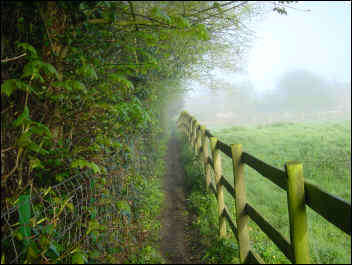
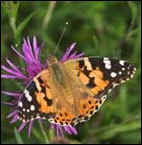 Insects
ustilise the full gamut of survival strategies for the winter
months. The more obvious species such as butterflies are perhaps
the most adaptable. Some over-winter as full-grown adults and we
will already have noticed those Peacocks and Red Admirals, wings
folded, in a dry nook or cranny in the garden shed or greenhouse.
Some, such as the Small Tortoiseshell, start hibernating amazingly
early, around July time, emerging the following March or April.
Other species over-winter in the egg stage, still others as pupae,
whilst such migratory species as Painted Lady rely totally
on early spring arrivals from North Africa to give us a resident
population later in the year.
Insects
ustilise the full gamut of survival strategies for the winter
months. The more obvious species such as butterflies are perhaps
the most adaptable. Some over-winter as full-grown adults and we
will already have noticed those Peacocks and Red Admirals, wings
folded, in a dry nook or cranny in the garden shed or greenhouse.
Some, such as the Small Tortoiseshell, start hibernating amazingly
early, around July time, emerging the following March or April.
Other species over-winter in the egg stage, still others as pupae,
whilst such migratory species as Painted Lady rely totally
on early spring arrivals from North Africa to give us a resident
population later in the year.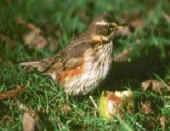 By
October, with un-seasonal north and east winds, winter migrants
such as Redwings and Fieldfares were already
streaming across the country. In fact the first record of Redwing
in Berkshire occurred on 24th September. By the way,
there are currently large numbers of Waxwings in Scotland
and North-east England, indicating an ‘irruption’ year, so do
keep an eye open in supermarket car parks, where often the higher
concentrations of their favourite food-plants, Rowan and Cotoneaster
are planted.
By
October, with un-seasonal north and east winds, winter migrants
such as Redwings and Fieldfares were already
streaming across the country. In fact the first record of Redwing
in Berkshire occurred on 24th September. By the way,
there are currently large numbers of Waxwings in Scotland
and North-east England, indicating an ‘irruption’ year, so do
keep an eye open in supermarket car parks, where often the higher
concentrations of their favourite food-plants, Rowan and Cotoneaster
are planted.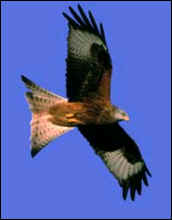 Then
of course there are ‘our’ Red Kites, which have grouped
in equally spectacular numbers at various times this autumn, the
highest single gathering I have witnessed being no less than 46
individuals! Readers may well have seen the sensationalised
headlines about this bird in a recent front-page story concerning
a Kite reported as trying to carry off a full-grown Terrier, and
the furore caused amongst knowledgeable and experienced people in
the letters columns which followed. Very little of what I said to
reporters in a 15-minute interview was used in the piece and, with
so many Kites in the Cookhams, it needs to be said that this bird
has the smallest feet of any of the ‘birds of prey’, only
about the size of a pigeon’s foot. It could no more wrap them
around an animal of the size of this dog than it could an
elephant! Secondly, it only weighs about 1kg and could only fly
off with small prey such as rats, young rabbits and the like. It
is a bird of carrion, not a killer like other raptors. This
autumn, I have seen up to 10 at a time on recently ploughed fields
behind the cricket pitch and alongside Long Lane eating worms and
leather-jackets. If this dog was attacked by a bird, it would have
to be more like a large falconers bird such as an Eagle Owl or
one of the larger eagles often used in displays, and which escape
with amazing regularity (typically 1000 such birds flying free at
any one moment nation-wide).
Then
of course there are ‘our’ Red Kites, which have grouped
in equally spectacular numbers at various times this autumn, the
highest single gathering I have witnessed being no less than 46
individuals! Readers may well have seen the sensationalised
headlines about this bird in a recent front-page story concerning
a Kite reported as trying to carry off a full-grown Terrier, and
the furore caused amongst knowledgeable and experienced people in
the letters columns which followed. Very little of what I said to
reporters in a 15-minute interview was used in the piece and, with
so many Kites in the Cookhams, it needs to be said that this bird
has the smallest feet of any of the ‘birds of prey’, only
about the size of a pigeon’s foot. It could no more wrap them
around an animal of the size of this dog than it could an
elephant! Secondly, it only weighs about 1kg and could only fly
off with small prey such as rats, young rabbits and the like. It
is a bird of carrion, not a killer like other raptors. This
autumn, I have seen up to 10 at a time on recently ploughed fields
behind the cricket pitch and alongside Long Lane eating worms and
leather-jackets. If this dog was attacked by a bird, it would have
to be more like a large falconers bird such as an Eagle Owl or
one of the larger eagles often used in displays, and which escape
with amazing regularity (typically 1000 such birds flying free at
any one moment nation-wide).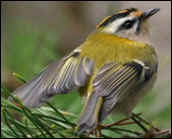 gambolling
together on the adjacent Jubilee River this month. Judith Goodwin
had what might have been a Willow Tit in her local garden,
a now very scarce species in the region, but it turned out to be a
Marsh Tit, which nonetheless is a rapidly declining bird in
the Thames Valley. Pam Knight has kept us up to date with activity
on her garden feeding station, and the haunting sounds of local
owls and Pam Raisey noted a rare Firecrest along Strand
Lane this summer, of particular interest given the breeding
success of this nationally-scarce species in nearby Cliveden, as
reported earlier. Thanks to them and all our other correspondents.
gambolling
together on the adjacent Jubilee River this month. Judith Goodwin
had what might have been a Willow Tit in her local garden,
a now very scarce species in the region, but it turned out to be a
Marsh Tit, which nonetheless is a rapidly declining bird in
the Thames Valley. Pam Knight has kept us up to date with activity
on her garden feeding station, and the haunting sounds of local
owls and Pam Raisey noted a rare Firecrest along Strand
Lane this summer, of particular interest given the breeding
success of this nationally-scarce species in nearby Cliveden, as
reported earlier. Thanks to them and all our other correspondents.